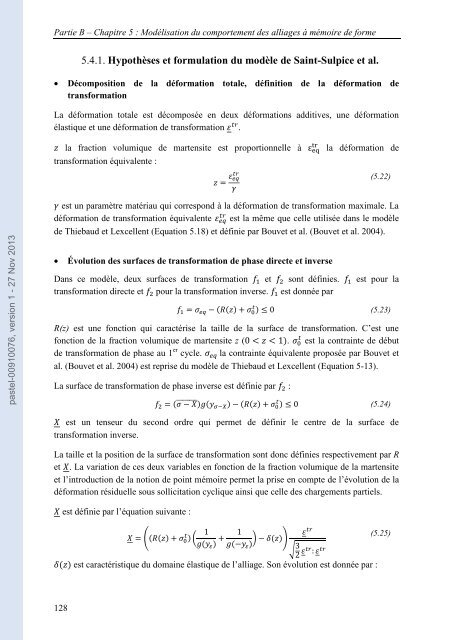Dialogue essais-simulation et identification de lois de comportement ...
Dialogue essais-simulation et identification de lois de comportement ...
Dialogue essais-simulation et identification de lois de comportement ...
Create successful ePaper yourself
Turn your PDF publications into a flip-book with our unique Google optimized e-Paper software.
Partie B – Chapitre 5 : Modélisation du <strong>comportement</strong> <strong>de</strong>s alliages à mémoire <strong>de</strong> forme<br />
5.4.1. Hypothèses <strong>et</strong> formulation du modèle <strong>de</strong> Saint-Sulpice <strong>et</strong> al.<br />
<br />
Décomposition <strong>de</strong> la déformation totale, définition <strong>de</strong> la déformation <strong>de</strong><br />
transformation<br />
La déformation totale est décomposée en <strong>de</strong>ux déformations additives, une déformation<br />
élastique <strong>et</strong> une déformation <strong>de</strong> transformation .<br />
la fraction volumique <strong>de</strong> martensite est proportionnelle à<br />
transformation équivalente :<br />
la déformation <strong>de</strong><br />
(5.22)<br />
pastel-00910076, version 1 - 27 Nov 2013<br />
est un paramètre matériau qui correspond à la déformation <strong>de</strong> transformation maximale. La<br />
déformation <strong>de</strong> transformation équivalente est la même que celle utilisée dans le modèle<br />
<strong>de</strong> Thiebaud <strong>et</strong> Lexcellent (Equation 5.18) <strong>et</strong> définie par Bouv<strong>et</strong> <strong>et</strong> al. (Bouv<strong>et</strong> <strong>et</strong> al. 2004).<br />
<br />
Évolution <strong>de</strong>s surfaces <strong>de</strong> transformation <strong>de</strong> phase directe <strong>et</strong> inverse<br />
Dans ce modèle, <strong>de</strong>ux surfaces <strong>de</strong> transformation <strong>et</strong> sont définies. est pour la<br />
transformation directe <strong>et</strong> pour la transformation inverse. est donnée par<br />
(5.23)<br />
R(z) est une fonction qui caractérise la taille <strong>de</strong> la surface <strong>de</strong> transformation. C’est une<br />
fonction <strong>de</strong> la fraction volumique <strong>de</strong> martensite z ( . est la contrainte <strong>de</strong> début<br />
<strong>de</strong> transformation <strong>de</strong> phase au 1 er cycle. la contrainte équivalente proposée par Bouv<strong>et</strong> <strong>et</strong><br />
al. (Bouv<strong>et</strong> <strong>et</strong> al. 2004) est reprise du modèle <strong>de</strong> Thiebaud <strong>et</strong> Lexcellent (Equation 5-13).<br />
La surface <strong>de</strong> transformation <strong>de</strong> phase inverse est définie par :<br />
(5.24)<br />
est un tenseur du second ordre qui perm<strong>et</strong> <strong>de</strong> définir le centre <strong>de</strong> la surface <strong>de</strong><br />
transformation inverse.<br />
La taille <strong>et</strong> la position <strong>de</strong> la surface <strong>de</strong> transformation sont donc définies respectivement par R<br />
<strong>et</strong> . La variation <strong>de</strong> ces <strong>de</strong>ux variables en fonction <strong>de</strong> la fraction volumique <strong>de</strong> la martensite<br />
<strong>et</strong> l’introduction <strong>de</strong> la notion <strong>de</strong> point mémoire perm<strong>et</strong> la prise en compte <strong>de</strong> l’évolution <strong>de</strong> la<br />
déformation résiduelle sous sollicitation cyclique ainsi que celle <strong>de</strong>s chargements partiels.<br />
est définie par l’équation suivante :<br />
(5.25)<br />
est caractéristique du domaine élastique <strong>de</strong> l’alliage. Son évolution est donnée par :<br />
128
















